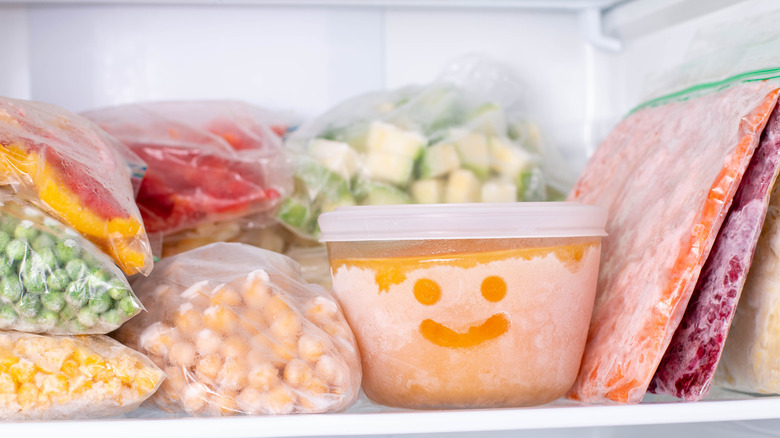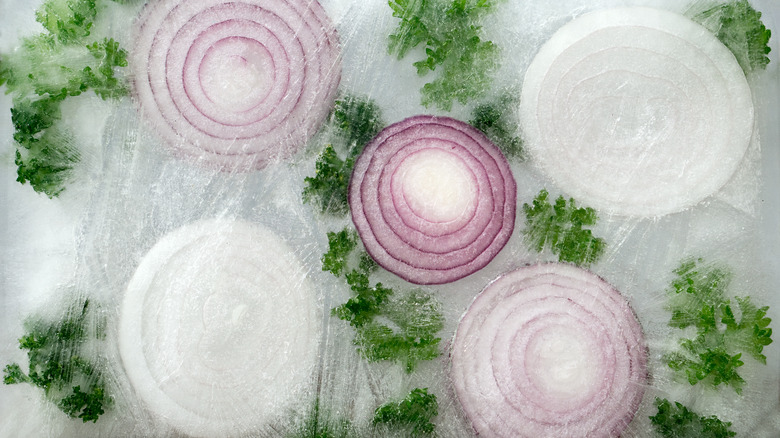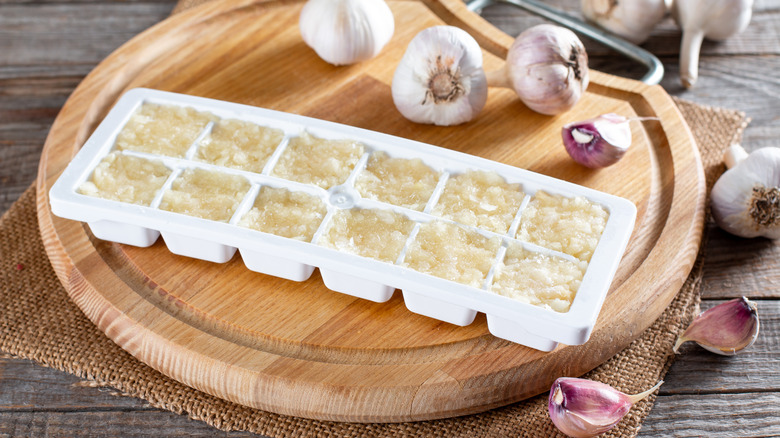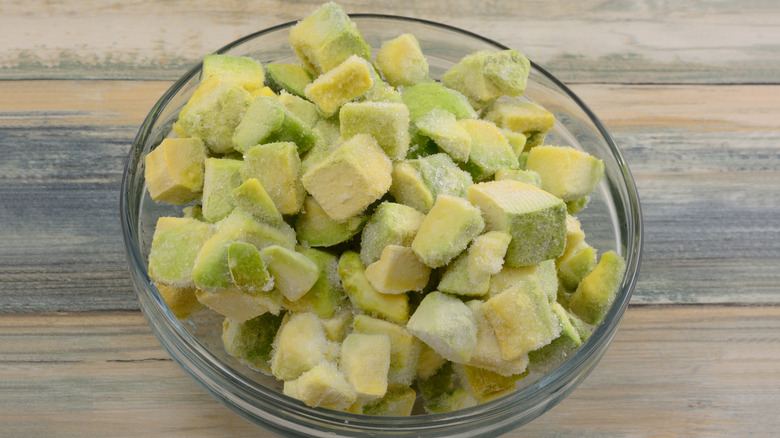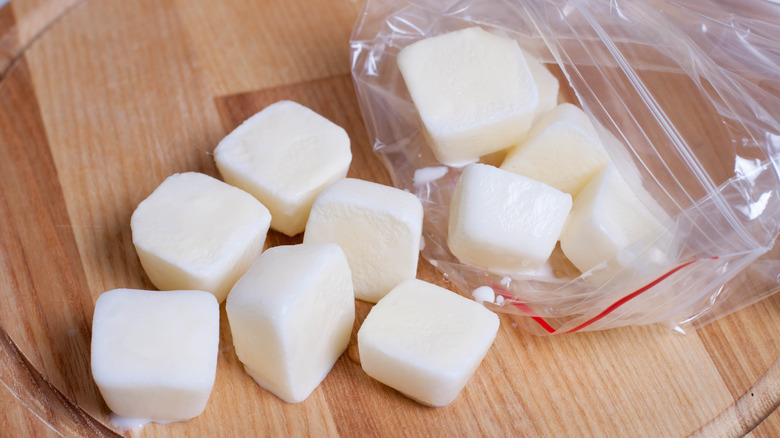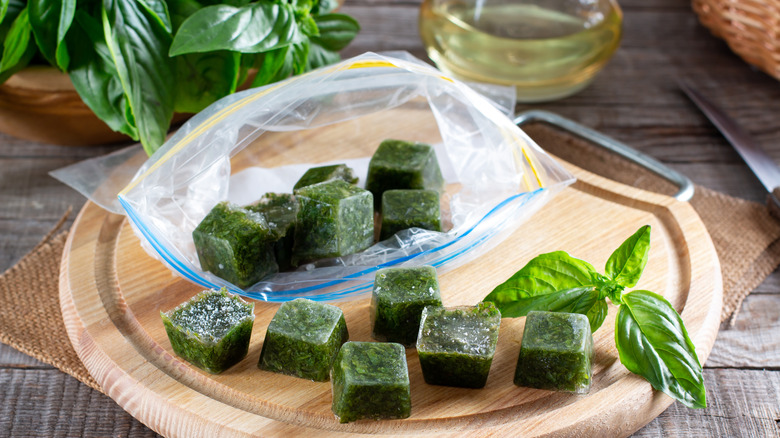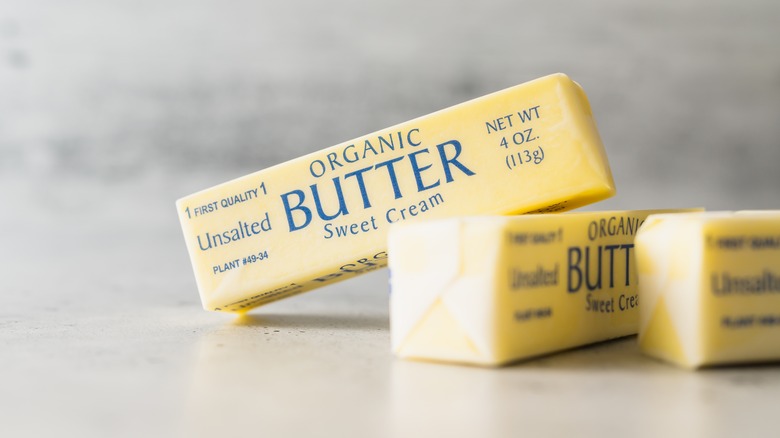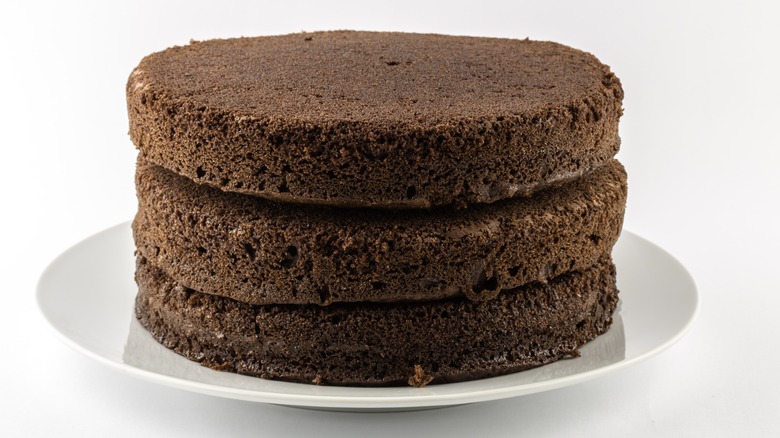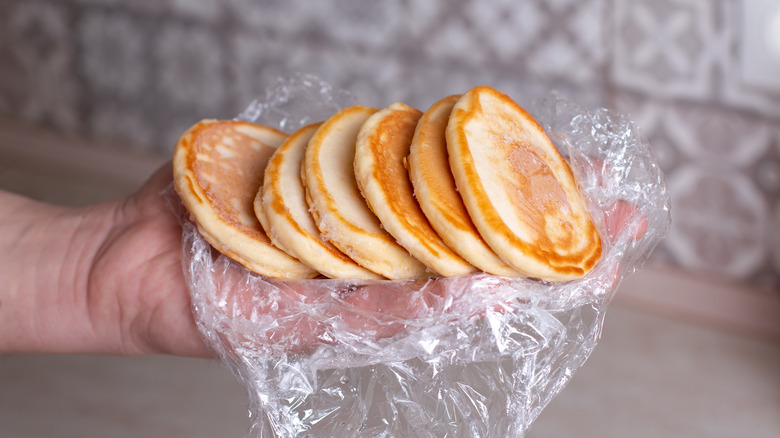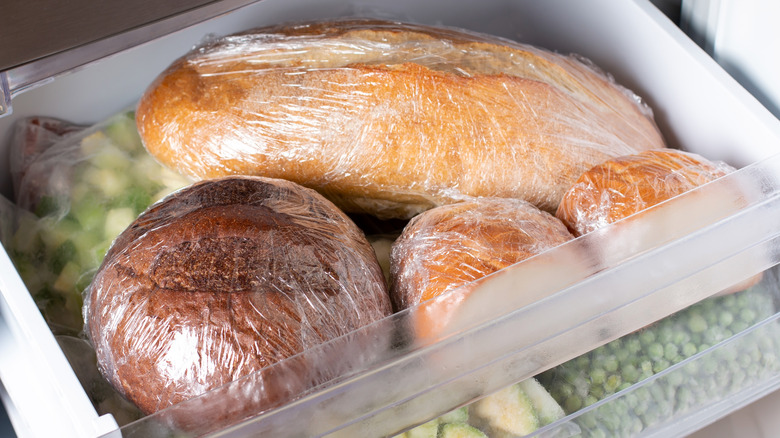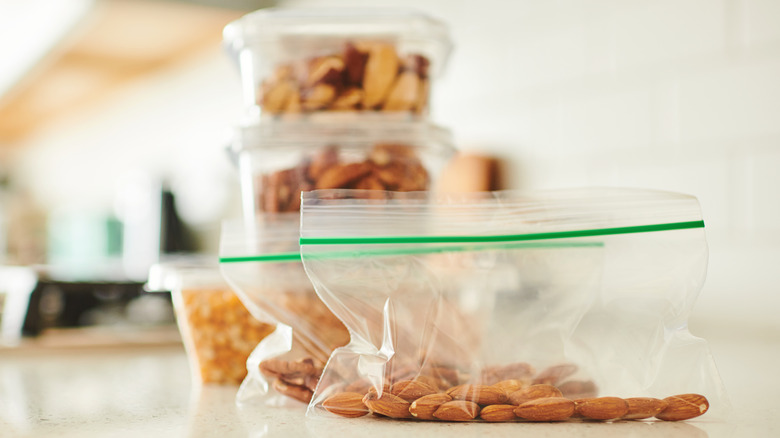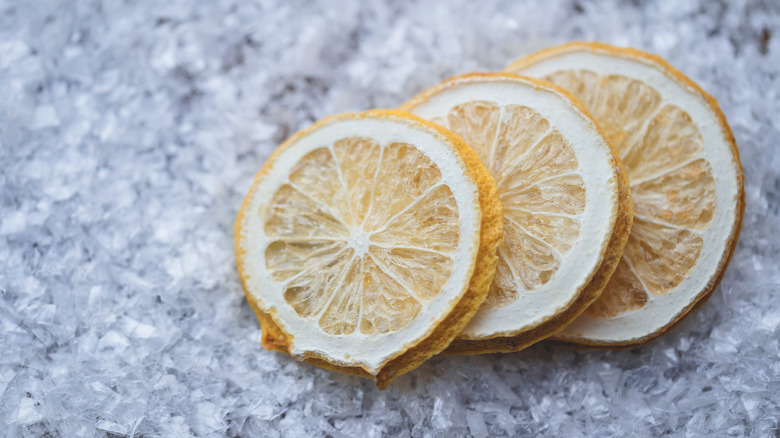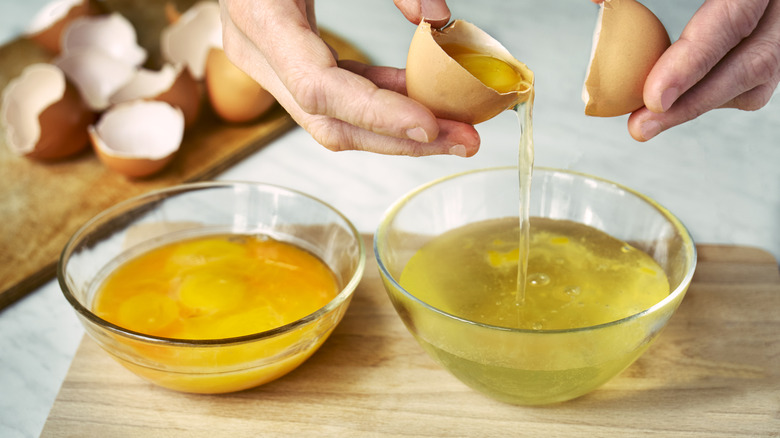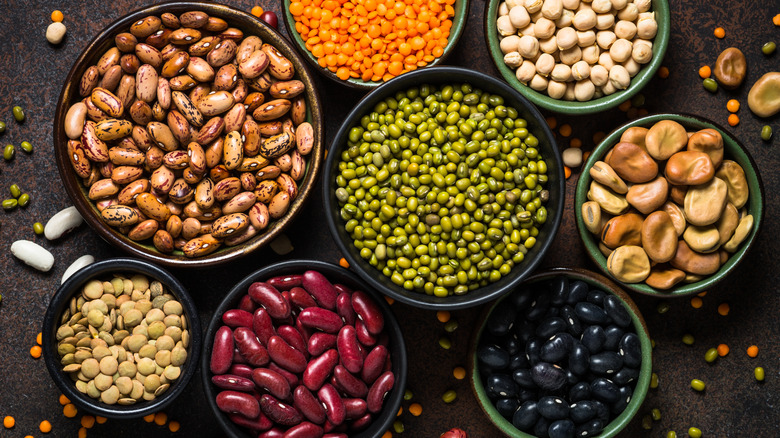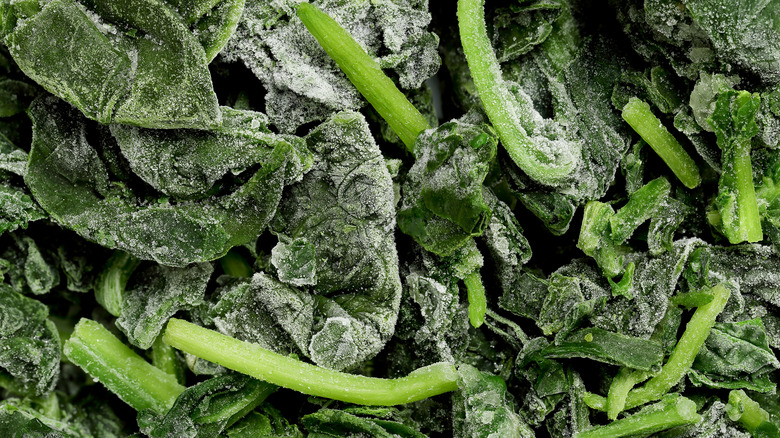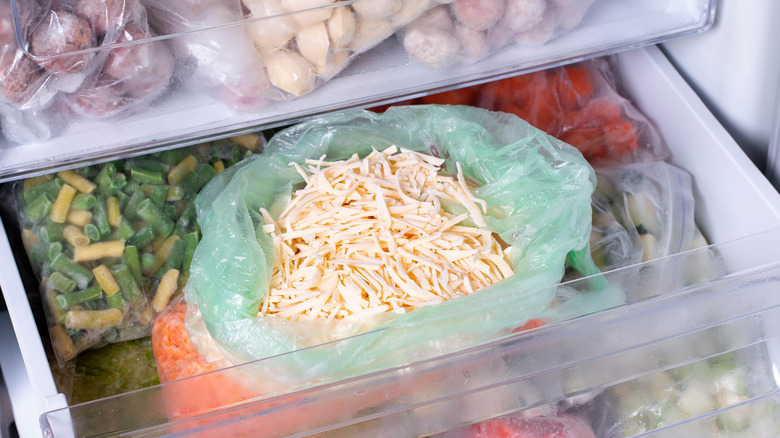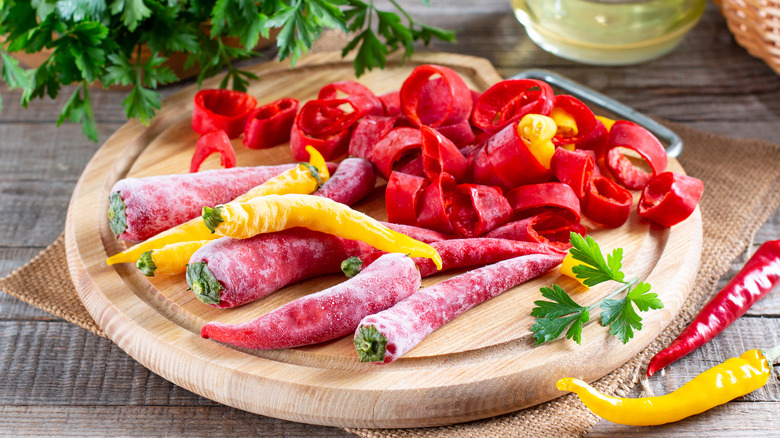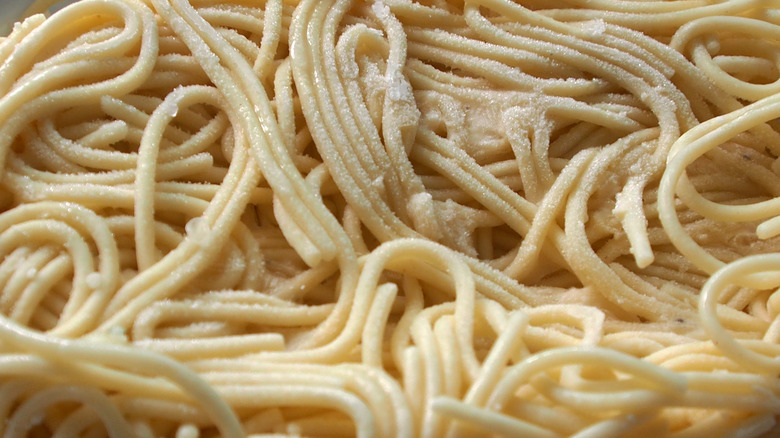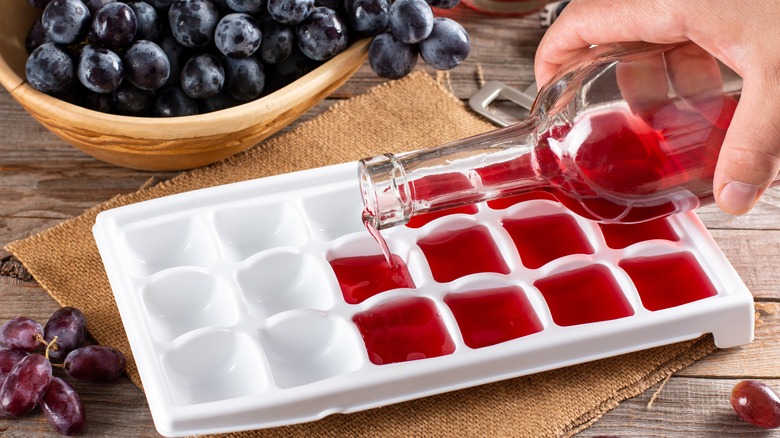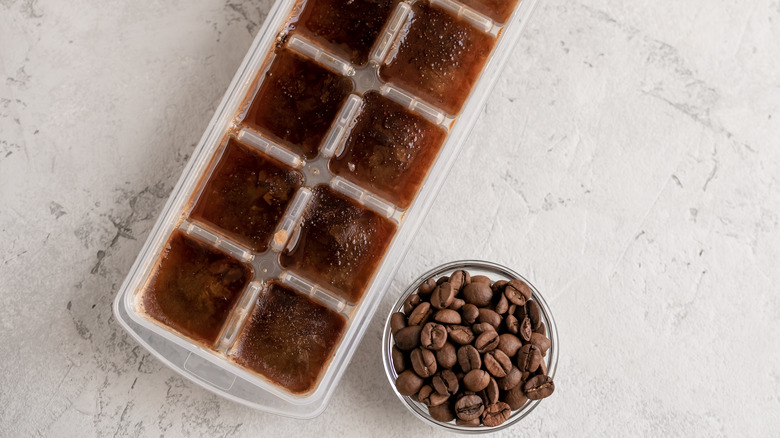Did You Know You Can Freeze These 19 Foods And Drinks?
If all you're using your freezer for is storing ice packs, TV dinners, and pints of rocky road, you're definitely underutilizing one of the most practical appliances in the kitchen. Many food items with shorter shelf lives are unnecessarily wasted when they could be saved with a timely stint in the freezer, including some surprising ingredients you may have never realized were freezable, from baked goods to dairy products and everything in between.
There are a few rules of thumb to keep in mind when freezing foods. First, if something is in bad shape, the freezer won't fix it, so don't bother with over-the-hill produce or expired items. Second, as moisture in foods freezes, it'll change the item's texture, so ingredients with high water content are generally not good freezer candidates (think juicy vegetables like celery and tomatoes). Third, make sure whatever you freeze is tightly wrapped and/or enclosed in an airtight vessel, or it'll take on unpleasant flavors and aromas as it's stored, due to oxidation.
Once you've got these guidelines down pat, check out this handy list of foods you can freeze. Taking advantage of these items' abilities to last a long time in sub-zero temperatures can save you meal prep time, as well as money by cutting back substantially on food waste.
Onions
Onions are a staple ingredient for so many recipes, yet prepping them can be a pain. Sometimes the thought of subjecting yourself to teary-eyed misery is enough to turn you off cooking altogether. But if you can bring yourself to prep a big batch of onions once and freeze them, you won't have to worry about them again for months.
You can freeze onions in any form you like: Minced, diced, sliced, cubed, or even whole. For chopped onions, it helps to portion them out in ice cube trays or freezer bags so you can grab a little at a time when you need them. Whole onions must be blanched first (placed in boiling water for several minutes, then cooled) or they can go mushy on you and may be unsafe to eat. Frozen onions will keep for at least three months and up to six.
Garlic
Like onions, garlic is a necessary addition to just about every savory recipe from cuisines the world over. Luckily, it also freezes well, so you can ensure you always have some of this boldly aromatic ingredient on hand ready to throw in a hot pan or simmering pot.
Garlic can be frozen in quite a few ways, depending on how you want to use it in your cooking endeavors. The entire head of garlic can be frozen, and although this doesn't help with future prep work, it will keep it from going bad — useful if you have too many bulbs lying around. Cloves can be frozen peeled or unpeeled. You can dice, chop, mince, or even purée your garlic and freeze it in convenient portions. For the best flavor, whole bulbs of garlic should be eaten before six months, with peeled garlic best used within a few weeks.
Avocado
Everyone knows the heartbreak of the avocado: You painstakingly select one that you believe will be at perfect ripeness when you need it, only for it to become brown mush on your countertop. The shelf life of a fresh avocado is tragically short, but you can easily extend it to a more reasonable length just by using your freezer.
The secret to successfully freezing avocados is to keep the fruit's flesh away from air as much as possible. Mashing them and storing them in a freezer-safe bag makes this easy, as you can press all of the air out and seal it tight. A vacuum sealer can be used to do the same to chunks or halves. Otherwise, avocados can be frozen in their entirety, as their pebbled skin works as a natural barrier. Frozen avocado keeps for up to a month. Once thawed, use it immediately.
Milk and cream
Dairy products don't last forever, and nothing is more frustrating than having to pour a gallon of expired milk down the drain. Items like milk, buttermilk, cream, and half-and-half can be frozen to extend their life, although it's worth noting that they'll separate and their texture won't be the same as fresh. As a result, they'll be better suited to cooking and baking than drinking. A bit of frozen cream or half-and-half will still mix well into coffee, though.
Make sure these items aren't past their expiration date when you freeze them. Also, keep in mind that milk will expand, so give it a container made of a material that won't crack or break, with some space to accommodate it. Thaw and use these dairy products within a few months. Milk can keep for up to six months, but starts to lose quality after six weeks.
Fresh herbs
Having fresh herbs on hand is a must for any chef. Whether you store them on the countertop or in the fridge, though, they never last long, becoming wilted and brown and losing their aromas and flavors. You can dry herbs to preserve them, but this alters their taste and texture. To keep their pop of bright, fresh, just-picked-from-the-garden taste, freezing is the way to go.
Hardy herbs like rosemary, thyme, and sage can be frozen whole. More delicate, leafy herbs like basil, cilantro, and parsley retain their flavor best when stored in ice: Wash, dry, and chop the leaves, add them to an ice tray, and cover with water. Herbs frozen like this can last up to 12 months. You can use oil instead of water too. Olive oil is a good choice, but a household freezer is cold enough to freeze any common cooking oil.
Butter
If you make a lot of pies, pastries, and biscuits, you've likely already dealt with frozen butter, so it's probably not a surprise to know that the substance takes well to sub-zero temperatures. Freezing butter is super easy, so if you see a good deal on a bulk purchase, don't be afraid to take advantage of it, as long as you have room in the freezer.
You don't even need to take butter out of its packaging — just toss the box in the freezer and you're good to go. If it's already been opened, you can store it in any freezer-safe wrapping and container. Butter can be used frozen in baking recipes, or thawed in the refrigerator. Salted butter will keep for nine months, while unsalted is good for five.
Cakes, pies, and cookies
Many sweet treats take well to freezing. This can be a game-changer if you always find yourself stressing and short on time planning birthday parties or holiday meals. Get the dessert made ahead of time and pop it in the freezer and you have one less thing to worry about.
Unadorned and unfrosted cakes can last as long as three months wrapped up tight in the freezer, and can be frosted and finished after a thaw in the refrigerator. Fruit and nut pies handle the cold nicely, whether you bake them first or not. Cookie dough loves to be frozen, and you can throw baked cookies in the freezer too, ideally individually wrapped and unfrosted. For all of these goodies, use a tight layer of plastic wrap followed by a layer of foil for best results and to protect from freezer burn.
Pancakes and waffles
Is there any feeling better than waking up in the morning and knowing you can have a hot plate of classic pancakes or homemade waffles without doing any work? If you've got some in the freezer, you can feel that every day. So go ahead and make a big batch and store whatever you don't eat for later.
Guidelines for pancakes and waffles are roughly the same: Cook them up, let them cool, wrap them individually or stack them separated with parchment or foil, and store them in the freezer. They reheat quickly and easily in an oven, toaster oven, or microwave, with no thawing required. They'll keep for two months.
Bread
Beautifully baked bread is a magnificent thing. Sadly, bread doesn't stay perfect for long, and if you're not feeding a group of people it can be tough to get through a whole loaf before staleness creeps in. If you find yourself with this problem often, consider freezing your bread and it'll last up to three months.
Store-bought loaves, sliced or whole, can be tossed in the freezer in their original packaging. Artisanal loaves that aren't in sealed packaging, and homemade bread, can be frozen successfully as long as you wrap them tightly in a combination of cling wrap and foil, or cling wrap and a freezer bag. If your frozen bread is pre-sliced, no need to thaw — the slices can be heated right away in a toaster or toaster oven. Whole loaves should be unwrapped and defrosted in the oven.
Nuts
On the surface, nuts may seem like eternally shelf-stable food but, in reality, there are oils in nuts that can make them go rancid fairly quickly if left at room temperature or warmer. They can also simply lose their texture and become stale and unpleasant. The best way to avoid this scenario is to make sure the nuts stay as cold as possible — so throw them in the freezer and enjoy them without worry for up to a year.
The larger and less broken down the nuts are, the longer they'll last in the freezer. Keep them in the shells or whole, if possible, for best results; sliced or chopped nuts won't keep for quite as long. Any freezer bag or airtight container can be used.
Citrus
Instead of leaving your limes, lemons, and oranges in a fruit bowl where they can grow moldy and attract fruit flies, you can keep them fresh and zingy longer by storing them in your freezer. Frozen citrus fruit and zest will keep its bright flavor for around three or four months.
Slices and wedges will regain life fairly quickly once you pull them from the freezer. Whole fruits that have been frozen will take a bit longer, but you can easily thaw them by soaking them in cold water until they regain their juiciness. Citrus juice is a great thing to freeze, too, and will last even longer — while its flavor is best within three to four months, freshly squeezed lemon juice kept constantly below 0 degrees Fahrenheit can stay safe to use indefinitely.
Eggs without their shells
It may seem unlikely because of how delicate they are, but eggs are great candidates for the freezer, as long as they're out of their shells. You just need to keep in mind a few guidelines, as different parts and preparations of eggs will react differently with a stint in super cold temps.
Cooked egg whites don't freeze well, but raw ones do. Once separated from the yolks, they can simply be added to a bag or other airtight container and popped into the freezer. Whole eggs can easily be frozen too, as long as the whites and yolks are beaten together beforehand. For just yolks, you'll need to mix in either salt or sugar before freezing to stop them from thickening. Eggs will keep frozen for up to a whole year.
Grains and beans
Legumes such as beans and lentils, as well as whole grains, can bring a lot of heart-healthy nutrition to your diet. But preparing them from scratch takes ages, and often multiple steps. While canned versions are more convenient, they can include unwelcome additives. Fortunately, you can get all of the time-consuming prep out of the way in one fell swoop and make big batches of most grains and beans because once cooked, they freeze quite well.
Use any freezer-safe, airtight container for your beans and grains, and keep them in the freezer for up to six months. Pretty much all beans are sturdy enough to bounce back after being frozen, but some softer grains and legumes such as lentils may come out a bit mushy on the other side. Still, if your priority is saving time, it may be worth it.
Leafy greens
Not all leafy greens take well to arctic temperatures, but many do. You can save yourself from having to chuck bunches of browned and slimy leaves in the trash by properly prepping and freezing greens such as kale, spinach, collard greens, and chard.
Make sure you clean them thoroughly, then blanch them using steam or by dunking them right in boiling water. This step helps keep them fresh and bright for longer. Immediately after blanching, chill the greens quickly in an ice bath, drain out all the moisture, and then pack them in an airtight container or bag and freeze. Frosty leafy greens will stay in good shape for a long time, up to a year. More delicate salad greens, like lettuces, should stay out of the freezer.
Cheese
Freezing cheese is tricky, but you can successfully extend the life of many types of cheeses by putting them on ice. It won't work well with many cheeses that have a lot of moisture or have delicate soft textures, like Brie or ricotta. But take a low-moisture, semi-hard cheese such as Cheddar or Gouda and you're good to go.
These cheeses can be frozen in blocks, cubes, or grated and, as always, in a freezer bag or other airtight container. Their texture likely won't be the same upon thawing, so defrosted cheeses are best suited for cooking rather than eating as-is. Depending on the particular cheese, its flavor should stay good for at least six months.
Chili peppers
Mild, medium, hot, or wildly fiery, any chili pepper can be frozen for later use. There are a lot of ways to do it, the easiest being to just leave them whole, stick them in a freezer bag, and throw them in the freezer. Make sure to wash and dry them thoroughly first.
If you choose to slice or chop your peppers first, you can, keeping the seeds or ditching them depending on your preference. Be careful, as the oil from peppers can irritate and burn skin — wearing gloves is a good way to prevent this. Frozen peppers will keep their potency for six months.
Rice and pasta
Having a workhorse starch around, like pasta or rice, cooked and ready to go can make dinner prep a breeze. All types of rice, and most kinds of pasta, take well to freezing and just need a quick reheat in a pot, pan, or microwave before hitting your plate.
With rice, make sure it's thoroughly cooked and cooled before portioning it out in airtight containers. Pasta should be cooked al dente so it keeps its shape when it's reheated. Delicate styles, like angel hair, won't hold up as well, but sturdy shapes like penne and hefty noodles like lasagne do extremely well. Stuffed varieties like ravioli and tortellini are also well-suited for the freezer. Frozen rice will keep for two months, and pasta typically around six.
Wine
Sure, you can freeze wine — but why would you want to? You shouldn't store wine in the freezer for drinking, especially not in anything made from glass, as wine expands as it freezes and can leave you with an unsealed cork or, more disastrously, a broken bottle. However, there are a few methods and uses for frozen wine that are worth checking out.
On a hot day, a wine slushie — perhaps you've heard of "frosé" — is one of the most refreshing tipples you can treat yourself with. Just make sure you freeze the wine in a safe container, not in the bottle, and don't leave it in the freezer too long or it'll lose flavor. You can enjoy it as-is or throw it in a blender. Wine can also be frozen in ice cube trays and kept on hand for cooking.
Coffee
Some of us have eyes bigger than our mugs when we go to brew coffee in the morning, and are left with a pot still half-full of leftover java. It's never as good reheated as it is when it's fresh brewed but it always seems like a shame to waste it. One way to salvage your excess joe is to turn it into frozen coffee cubes.
These frozen coffee cubes are hands-down the best way to turn hot coffee into iced coffee. Instead of regular ice cubes which dilute the coffee's taste, they'll keep it intensely flavored and strong. They're also the perfect thing to throw into a morning cherry mocha smoothie for a caffeine boost. When freezing coffee, just make sure it's not exposed to air or it'll pick up off flavors and aromas. Frozen coffee won't go bad, but it should stay good for at least three months.
